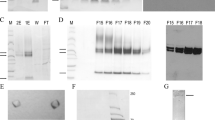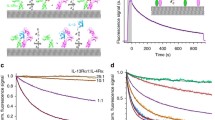Summary
The type III receptor for transforming growth factor beta (TGFβ), which exhibits no kinase activity, binds TGFβ1 and TGFβ2 and is involved in assembly and activity of the multi-subunit TGFβ signal transduction complex. Recently we showed that TGFβ receptor type III (TβRIII) can participate in a complex composed of the dimeric TGFβ ligand and a type III, II, and I receptor subunit. The interaction of the TβRIII subunit with TβRII is TGFβ-dependent, whereas interaction with TβRI is TGFβ-independent. Here we use coexpression of the three types of TGFβ receptors in baculoviral-infected insect cells to determine which parts of the unglycosylated TβRIII receptor participate in the binding of TGFβ, the TGFβ-dependent interaction with TβRII and the TGFβ-independent interaction with TβRI. The results suggest that the first 500 amino acid residues in the aminoterminal portion of TβRIII exhibit all three properties.
Similar content being viewed by others
References
Cheifetz, S.; Massague, J. Transforming growth factor-β (TGF-β) receptor proteoglycan. J. Biol. Chem. 264:12025–12028; 1989.
Fukushima, D.; Butzow, R.; Hildebrand, A., et al. Localization of transforming growth factor β binding site in betaglycan. J. Biol. Chem. 268:22710–22715; 1993.
Hou, J.; Kan, M.; McKeehan, K., et al. Fibroblast growth factor receptors from liver vary in three structural domains. Science 251:665–668; 1991.
Kaname, S.; Ruoslahti, E. Betaglycan has multiple binding sites for transforming growth factor-β1. Biochem. J. 315:815–820; 1996.
Lopez-Casillas, F.; Payne, H. M.; Andres, J. L., et al. Betaglycan can act as a dual modulator of TGF-β access to signaling receptors: mapping of ligand binding and GAG attachment sites. J. Cell Biol. 124:557–568; 1994.
Lopez-Casillas, F.; Wrana, J. L.; Massague, J. Betaglycan presents ligand to the TGFβ signaling receptor. Cell 73:1435–1444; 1993.
Luo, K. X.; Lodish, H. F. Signaling by chimeric erythropoietin-TGF-beta receptors: homodimerization of the cytoplasmic domain of the type I TGF-beta receptor and heterodimerization with the type II receptor are both required for intracellular signal transduction. EMBO J. 15:4485–4496; 1996.
Matsuzaki, K.; Kan, M.; McKeehan, W. L. Reconstitution of a pentameric complex of dimeric transforming growth factor beta ligand and a type I, II, III receptor in baculoviral-infected insect cells. In Vitro Cell. Dev. Biol. 32A:345–360; 1996.
McCaffrey, T. A.; Falcone, D. J.; Brayton, C. F., et al. Transforming growth factor-beta activity is potentiated by heparin via dissociation of the transforming growth factor-beta/alpha 2-macroglobulin inactive complex. J. Cell Biol. 109:441–448; 1989.
McCaffrey, T. A.; Falcone, D. J.; Du, B. Transforming growth factor-beta 1 is a heparin-binding protein: identification of putative heparin-binding regions and isolation of heparins with varying affinity for TGF-beta 1. J. Cell. Phys. 152:430–440; 1992.
Moustakas, A.; Lin, H. Y.; Henis, Y. I., et al. The transforming growth factor β receptors types I, II, and III form hetero-oligomeric complexes in the presence of ligand. J. Biol. Chem. 268:22215–22218; 1993.
Pepin, M.-C.; Beauchemin, M.; Collins, C., et al. Mutagenesis analysis of the membrane-proximal ligand binding site of the TGFβ receptor type III extracellular domain. FEBS Lett. 377:368–372; 1995.
Pepin, M.-C.; Beauchemin, M.; Plamondon, J., et al. Mapping of the ligand binding domain of the transforming growth factor β receptor type III by deletion mutagenesis. Proc. Natl. Acad. Sci. USA 91:6997–7001; 1994.
Weis-Garcia, F.; Massague, J. Complementation between kinase-defective and activation-defective TGF-beta receptors reveals a novel form of receptor cooperativity essential for signaling. EMBO J. 15:276–289; 1996.
Wrana, J. L.; Attisano, L.; Carcama, J., et al. TGFβ signals through a heteromeric protein kinase receptor complex. Cell 71:1003–1014; 1992.
Yamashita, H.; Hidenori, I.; Grimsby, S., et al. Endoglin forms a heteromeric complex with the signaling receptors for transforming growth factor-β. J. Biol. Chem. 269:1995–2001; 1994.
Yamashita, H.; ten Dijke, P.; Franzen, P., et al. Formation of heterooligomeric complexes of type I and type II receptors for transforming growth factor-β. J. Biol. Chem. 269:20172–20178; 1994.
Author information
Authors and Affiliations
Rights and permissions
About this article
Cite this article
Taniguchi, A., Matsuzaki, K., Nakano, K. et al. Ligand-dependent and -independent interactions with the transforming growth factor type II and I receptor subunits reside in the aminoterminal portion of the ectodomain of the type III subunit. In Vitro Cell.Dev.Biol.-Animal 34, 232–238 (1998). https://doi.org/10.1007/s11626-998-0129-3
Received:
Accepted:
Issue Date:
DOI: https://doi.org/10.1007/s11626-998-0129-3




